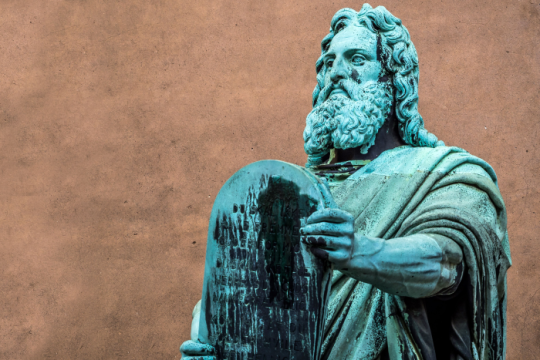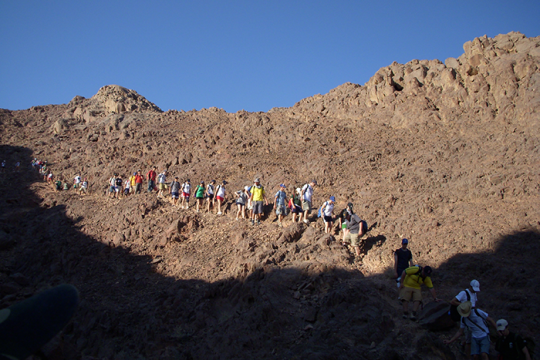The Torah and Haftarah readings for Rosh Hashanah all connect with, and illustrate, one or another of the themes of the holiday. I use the plural advisedly here, because there have been a variety of readings from early on-long before the onset of modernity and the Reform movement.
The reason for this has partially to do with different reading practices in the land of Israel and in the Babylonian diaspora. The early rabbinic practice in the land of Israel, attested in the third chapter of Mishnah Megillah, was to read brief portions each time the Torah was read and to finish up the entire Torah over a period of three and a half to four years. Each of the people who were called up to the Torah (aliyot) actually read from the scroll, a minimum of three verses. The blessings before and after the Torah reading were recited only once, at the beginning and end of the entire reading, respectively. Seven people read on Shabbat, three on weekdays, four on festivals, five on Rosh Hashanah, and six on Yom Kippur. This meant that the readings on holidays were also relatively brief. The Babylonian practice was to finish reading the Torah in one year. This meant that the individual sections were longer, and the holiday readings as well.
M. Megillah 3:5 lists the Torah reading for Rosh Hashanah as Lev. 23:23ff. This is the section of the festival calendar in Leviticus that deals with the holiday on the first day of the seventh month, which is to be “commemorated with loud blasts” (zichron t’ru’ah). Only three verses deal with this occasion; the chapter then goes on to discuss Yom Kippur and Sukkot. No Haftarah reading from the prophetic books is listed in the Mishnah. Nor is there a reading listed for the second day.1
In a parallel passage in the Tosefta, a legal text from the land of Israel that is just slightly later than the Mishnah (likely mid-3rd c. C.E. to the Mishnah’s date of early 3rd-century C.E.), the same Torah reading appears, but we are also informed that “there are those who say [that the reading is] “God took providential note of Sarah” [Vadonai pakad et Sarah; Gen. 21:1ff.]. This, in fact, becomes the traditional Torah reading for (the first day of) Rosh Hashanah. The reading relates to the Zichronot theme of the holiday, which is all about God’s taking note of Israel’s needs on Rosh Hashanah. Rabbinic aggadic traditions maintain that God took providential note of five barren women on Rosh Hashanah – Sarah, Rebecca, Rachel, Leah, and Hannah – and they all conceived on that day (Genesis Rabbah 73:1; Midrash Tanhuma, Vayera, 1). That is also why the Haftarah reading for the first day of Rosh Hashanah is the beginning of the book of Samuel, about Hannah’s prayer and Samuel’s miraculous birth. (This Haftarah is listed for the first time in the Babylonian Talmud, b.Megillah 31a, but is also represented in Pesikta Rabbati 43, a Byzantine-era midrashic collection from the land of Israel.)
No reading for the second day appears in any text from the land of Israel, as we have noted. The custom of observing two days of Rosh Hashanah took root instead in Babylonia. b. Megillah 31b gives the reading for the second day as Gen. 22:1ff., theAkedah (the Binding of Isaac). In rabbinic interpretation, this story links up with both theZichronot and Shofarot themes of the holiday. God’s providential care is signaled in the story’s outcome, where Isaac is saved, and also in the rabbinic notion of zechut akedat Yitschak, the merit of Isaac’s near-sacrifice, which his descendents invoke during the penitential season. According to a rabbinic aggadah, Abraham bargained with God at the end of the trial, insisting that, because he had done his part by not withholding Isaac, God must now protect Isaac’s descendents by remembering on their behalf this act of sacrifice every Rosh Hashanah, the annual Day of Judgment. God agrees to this demand and tells Abraham that, in order to remind God of this agreement, Isaac’s descendents should blow a ram’s horn on Rosh Hashanah in remembrance of the ram that was sacrificed instead of Isaac (Midrash Tanhuma, Vayera, 23). The Haftarah for the second day, also listed in b. Megillah 31b, is Jeremiah 31:20, “Is not Ephraim a beloved son to me? Whenever I speak of him, I remember him fondly.” This, too, invokes the Zichronot theme of God’s remembrance and attentiveness to Israel. The passage is also full of hope and encouragement for God’s return to Zion. Today, the Haftarah begins at Jeremiah 31:1 and ends with verse 20.
The post-talmudic custom, first recorded in Seder Rav Amram (2nd half of the 9th c. C.E.), was to take out two scrolls on all holidays and to read from the second scroll the Torah’s account, in Numbers 28-29, of the mandated sacrifices for that particular day. So the reading for Rosh Hashanah from the second scroll (both days) is Numbers 29:1-6. The Torah blessings before and after this reading are assigned to the Maftir, the person who reads the Haftarah.
European Reform prayer books, from the early nineteenth century onwards, generally presuppose a two-day observance of Rosh Hashanah and maintain the traditional Torah readings (although some, like the 1819 Hamburg prayer book, eliminated the Haftarah readings). The custom of observing only one day of Rosh Hashanah begins in the United States with the earliest Reform prayerbook, that edited by Rabbi Leo Merzbacher for Temple Emanuel in New York in 1855. The Torah reading there is Gen 22, the Akedah. This becomes the standard reading for all North American Reform prayer books that presuppose a one-day observance. (Gates of Repentance gives two service options for the evening and morning of Rosh Hashanah, thus allowing for a second-day observance. The Torah reading in the second service is Gen. 1:1-2:3, the Creation story, which relates to the Rosh Hashanah theme of Malchiyot, since on New Year’s Day God is acclaimed as Creator and Ruler of the world, which celebrates its “birthday” and is renewed on this day.
As for the Haftarah for a one-day observance of Rosh Hashanah, David Einhorn’s 1858 prayerbook is the first to list this as 1Sam 1ff. – even though this Haftarah reading actually links to Gen. 21, the miraculous birth of Isaac, which is not read. This custom is taken over by the Union Prayer Book (which begins the reading with Hannah’s prayer in Ch. 2) and maintained through Gates of Repentance. UPB and GOR also give various alternative Haftarot: Nehemiah 8, the renewal of the covenant and reading of the Torah by Ezra and Nehemiah to those returning to Zion (all editions of UPB and GOR); Isaiah 55, “Seek the Lord while he may be found, call ye upon Him while He is near” (which the Rabbis understood as referring to the penitential season of Rosh Hashanah, Yom Kippur, and the ten days between them; UPB 1922 and GOR); GOR also gives the traditional reading for the second day, Jer. 31:1-20, as an alternative. The Torah service materials for Rosh Hashanah in the new CCAR Mahzor have not yet been piloted, but the traditional readings with a variety of alternatives are being promised.
- This, together with similar passages in other rabbinic texts from the land of Israel, provides firm evidence that a second day of Rosh Hashanah was not observed there early on. It appears that the practice was first introduced by European immigrants in the Middle Ages.
Dr. Sarason is Professor of Rabbinic Literature and Thought and the Associate Editor of the Hebrew Union College Annual. He was ordained at HUC-JIR .


